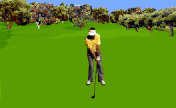There is an ineluctable link between rhythm and balance. There are players like Tom Watson who have much quicker tempos. On the other hand, one sees players like Ernie Els who play with a slower tempo. Whatever the case, there is equilibrium between their tempo and rhythm, which ensures a perfect golf swing.
The smoothness of pace and the maintenance of balance is what can help a player to attain lasting consistency with their swing. There are some mistakes that should be avoided by a golfer if he wants to perfect his art. One of them is rushing the swing, which leads to inconsistent contact as well as poor ball flight. Those who are extraordinary in the sport of golf do not lose their balance with a few exceptions, of course.
As it is, no one is perfect and even in the sporting careers of some of the best players there are some low moments. Their positions and movements are linked by their natural cadence. A golf swing by a seasoned pro generally seems effortless as one expert describes the approach in the words "swing easy and hit hard." The proper sequence of the body movement enables one to reach a posture of leverage and power. Calvin Peete, being a ten-time PGA Tour driving accuracy champion presents the success factors behind straight driving - balance, balance and more balance.
Achieving consistency is only possible if understanding is acquired about how the body gets its balance in the respective vital positions. The weight should be balanced between the right and left foot with the support of the player's middle and long irons, even while the spine is curved away from the target of focus. There should be no specific pressure on one particular heel or toe. As it is, on this level also attaining the right magnitude of balance is imperative and that is accomplished by a movement of the balls of the feet.
When the player arrives at the impact point, the majority of the weight should be transferred to the front foot. With the head positioned behind the ball and the hips shifting forward about four inches past their original position, the spine tilt is increased to twice its original angle. In short, propriety and coordination is what is required in the course of achieving this target that can only be attained by a lot of practice and hard work.




